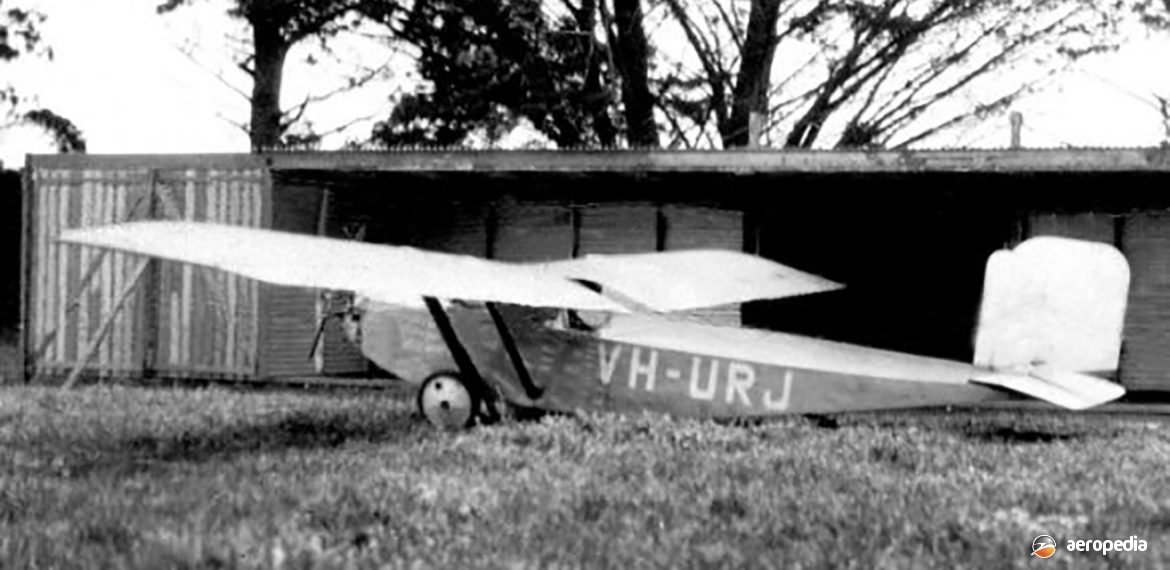Photograph:
Beardmore Wee Bee VH-URJ (unknown) in Victoria in about 1935 (Eddie Coates collection)
Country of origin:
United Kingdom
Description:
Two-seat light sport monoplane
Power Plant:
One 27 kw (36 hp) Bristol Cherub (1,096 cc) two-cylinder horizontally-opposed air-cooled engine
Specifications:
- Wingspan: 11.58 m (38 ft)
- Length: 6.76 m (22 ft 2 in)
- Wing area: 17.37 m² (187 sq ft)
- Max speed: 138 km/h (86 mph)
- Stalling speed: 58 km/h (36 mph)
- Ceiling: 4,420 m (14,500 ft)
- Empty weight: 210 kg (462 lb)
- Loaded weight: 380 kg (837 lb)
History:
The Beardmore WB.XXIV Wee Bee was designed in 1924 for the Lympne Light Aircraft trials by W S Shackleton for William Beardmore & Co Ltd of Dalmuri, Dumbarton Shire, in Scotland. This Company had undertaken some aeroplane design during World War I but the aviation division closed down after the cessation of hostilities. Designed for the two-seat competition, the WB.XXIV, or Wee Bee I as it was known, was fitted with a 24.3 kw (32.6 hp) [at 3,200 rpm] Bristol Cherub two-cylinder horizontally-opposed air-cooled engine.
The prototype was exhibited at a number of exhibitions, including Wembley in north-west London, and the Motor Cycle Show at Olympia in West Kensington. Plans were announced for production but this did not occur. In mid-1925 the prototype was registered as G-EBJJ (c/n WB.XXIV). In August that year it was flown in a series of air races, and was granted its Certificate of Airworthiness on 4 March 1930. It then had a couple of owners before being exported.
The machine was very compact and was of wood construction. By September 1924 it was said to meet its design specifications in every way and, during trials over a 20 km (12.5 mile) course, it covered ten laps (201 km / 125 miles) at 112.81 km/h (70.1 mph) at 56 km (35 miles) per Imp gallon. Later it claimed the $4,000 (£2,000) prize for the winner of the competition.
This machine was imported to Australia by the Larkin Aircraft Co and was registered on 26 April 1933 as VH-URJ (c/n WB.XXIV – ex G-EBJJ) to Mr P T Parker in Victoria. However, it only saw service for a year and was then retired for a period as the Cherub engine was notorious for “backfiring”, a number of propeller swingers having suffered injuries from this problem. Eventually a propeller sleeve and rope system was devolved to avoid further injury.
Eventually the Wee Bee was sold to Mr E R Betts, who flew it for some years. It was placed in storage at the beginning of World War II, at this time it being recorded as having some 3,252 hrs 59 mins on the airframe.
It seems that in October 1938 Mr Frederick Betts was flying the aircraft which hit a rock when landing at Pomberneit, VIC (Mr Betts was then the proprietor of a local garage). The aircraft was extensively damaged, photographic evidence showing it had broken its back. It was removed from the scene in parts, the rear fuselage being attached to the top of a vehicle. At that time the inscription on the tail of the aircraft stated “Wee Bee 1. Out-right winner £4000 British Light Plane Competition. Built by Beardmore Aviation, England”.
It would seem that the aircraft was placed in storage in parts and in fact existed up to about 1950. At that time it is said it was owned by Mr Vincent Boyes. He was said to have obtained the aircraft in 1949 at which time it needed extensive restoration. It did not have a current Certificate of Airworthiness and Department of Civil Aviation records stated it was removed from the Australian Civil Aircraft Register in August 1940. It is not known if this restoration work took place but some reports indicate it was damaged in another accident; others that it was used as a children’s playhouse.
As noted elsewhere, George Beohm with HC ‘Horrie’ Miller and Ernest W Beckman built an ANEC I for the 1924 Light Plane Competition held at Richmond, NSW but it was not completed in time. At about the same time Beohm commenced construction of a Wee Bee, this being a two-seater with a 45 kw (60 hp) Wright radial engine. However, Messrs Beckman and Beohm went to the United Kingdom in 1926 and the aircraft, so far as is known, was never completed.

